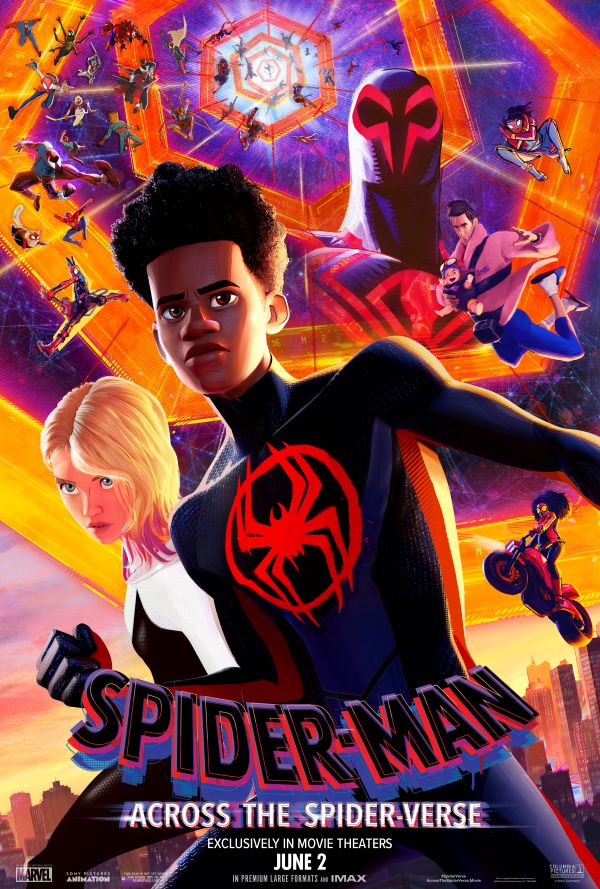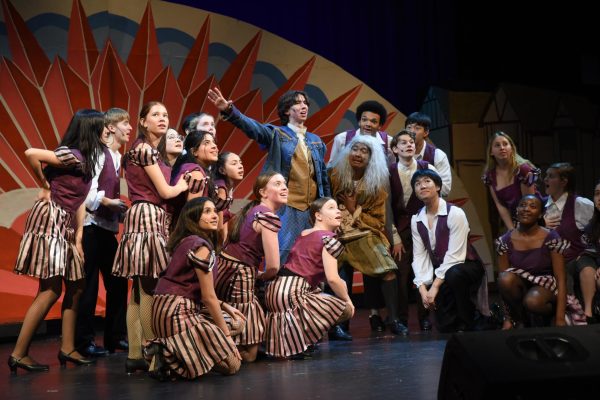Spider-man Across the Theatres
The size of the web expands as our anomaly spider-man, Miles Morales, re-enters the spider-verse to save the world from another multi-dimensional threat.
Back in December of 2018, the animated Spider-man movie, Spider-man: Into the Spider-verse, hit the screens. Within twelve days after its release, the movie grossed 138 million dollars and later won the “Best Animated Feature” award. Then, on December 13th, 2022, a trailer for Spider-man: Across the Spider-verse, a sequel to the previous movie, made itself known. For about half a year, people waited to see Miles’s new journey, and on June 2nd, they got to see his next leap of faith.
Compared to the first movie, Spider-man: Across the Spider-Verse exceeded expectations. The animation was smoother and much more action packed than the first movie while still retaining that comic-like, rough art style. Additionally, charismatic characters who developed in the last movie still faced new, scarier conflicts within this film. Miles Morales grew as a person, but the main struggle of being understood continued throughout the story, resonating with the same audience and maintaining the realness of his character. Even with previous themes still included within the story, the movie also focused on themes and topics that previously weren’t there. Themes such as the struggles of parenting and self sacrifice all emerged throughout the film.
At the beginning of Spider-man: Across the Spider-verse, Miles was greeted by Gwen, who was supposed to be in another universe. Although they had a good time, Miles knew she was hiding something. When he figured out what it was, he followed Gwen into the spider-verse and unknowingly entered Spider-man India’s world, meeting Pavitr, and later on Hobie, who was from Spider-man Punk.
Miguel O’Hara was soon introduced as the person who made the Spider-verse and was responsible for the multi-dimensional traveling watch Gwen and almost every other spider-person had. Miles was never introduced to the spider-verse because he was a problem, though he didn’t know that. His existence was an error in the canon story-line, something Miguel and his system called an anomaly. Due to his status as Spider-man, he needed to stick with the rest of the story every spider-person goes through to keep his world-line safe. This meant Miles had to let his dad die. The last fight in the movie was his escape from the Spider-verse as Miguel and every other spider-person hunted him down, trying to prevent him from saving his father.
Taking a leap of faith was the main lesson of Spider-man: Into the Spider-Verse. In Spider-man: Across the Spider-verse, Miles overcame even greater obstacles. The climax of the movie showed Miles deciding that he would save his dad no matter what, jumping off a bullet train after slipping away from Miguel’s grasp.
Miles Morales as Spider-Man was one of the main reasons why I loved and enjoyed watching Spider-man: Into the Spider Verse. He was a relatable character, messing things up while trying to reach expectations. In both movies, even if he was facing huge problems like saving the world and being a hero, he still struggled with relatable problems like having a close relationship with his father and his personal identity. He was as lost as any teenager, and since the audience was targeted towards teens, they could sympathize and feel understood. The change from the last movie was that he had grown, yet, he still had a huge secret to keep from his parents. He kept his identity as Spider-Man a secret because he thought that it would be difficult for his parents to understand and accept him. Although the plot is straightforward, it applies to almost any other secret teenagers typically hide from their parents. He remains witty with humor, fearful of his future and unheard by the world around him, representing what every student near their teenage years feels.
The side characters in Spider-man: Into the Spider-verse helped Miles realize who he wanted to be and pushed him forward. There were only a few side characters who ranged from different time periods to different species, and they all went through similar struggles. They were the only ones who probably understood each other, and that was where Miles fit in. In Spider-man: Across the Spider-verse, the important side characters were Gwen, Peter B. Parker, Miguel, Hobie and Miles’s parents. Characters on Miles’s side assisted him when he needed help, especially because he was new to the spider-verse. Miles fought or got along with them and they were the reason why the plot moved forward. Without Gwen and Miguel, Miles would’ve never been to the spider-verse, without his parents, he wouldn’t have fought so hard to return to them, and without Hobie, he wouldn’t have been able to escape Miguel’s cage. The main obstacle in this movie was, surprisingly, Miguel O’Hara. Miguel was an anti-hero; the reason why he wanted to stop Miles from saving his family was because saving his family meant the death of millions. Miles’s parents, no matter how many disputes they get into, are incredibly important to him. When he saw Miguel as a threat, he was determined to save his parents, even if Miguel told him it was impossible, and therefore set the table for Miles’s new journey in Spider-man: Beyond the Spider-verse.
The comic book art style gives a unique trait to the movie and makes it all the more endearing Somehow, the animation studio seamlessly added in onomatopoeias, narrative, thought boxes, squiggly lines and graphic dots all bringing the comic book story to life. The fight scenes and Miles traveling as Spider-man were, however, my favorite moments within the second movie. The camera moved with the actions of the characters, and the constant, graceful or controlled, non-stop swinging every spider-person did made for some awesome visuals. Overall, the cartoonish look combined with the smooth, flexible animation was visually pleasing to watch.
By the end of this movie, one would have received a clear message of the responsibility of being a hero and gotten to experience the characters’ loss while also having been laughing due to the humor the movie incorporated. The experience, artistry and story of Spider-man: Across the Spider-Verse is definitely a step up from Spider-man: Into the Spider-Verse and a wonderful continuation.

I’m Esther Kim, a senior. This is my third year here in journalism but also my first year as an editor. Some hobbies I indulge in are reading, writing,...







